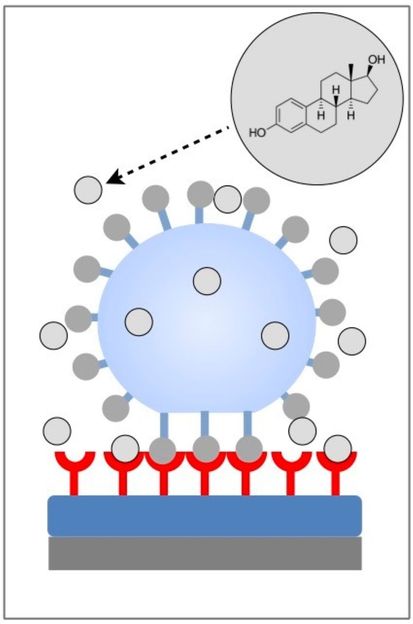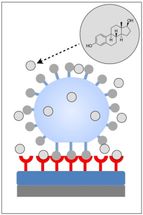Consumer protection: Novel method for detecting hormonally active substances
Analytical method for risk assessment of products and food
Scientists from the Universities of Dresden and Leipzig have presented a new method for detecting hormonally active substances in food, cosmetics and water in the journal “biosensors & Bioelectronics”. Hormonally active substances can cause serious health problems, including breast and prostate cancer, thyroid disorders, and neurological and mental illnesses. A fast and simple analytical method for risk assessment of products and food is therefore an important tool for health and consumer protection.

Symbolic image
pixabay.com

Scheme of the new detection principle.
Rettke et al


They are almost everywhere - in food, washing powder, dishwashing detergent, cosmetic products, in medicines as well as in drinking and waste water: hormonally active compounds such as synthetic estrogen derivatives, which are the main ingredient in hormonal contraceptives, or the "bulk chemical" bisphenol A (BPA), which is used for example in beverage bottles or food cans. Its harmful effects on humans and the environment have long been proven.
However, simple detection of endocrine disruptors for effective monitoring and reliable risk assessment of products and waters is a challenge due to the structural diversity of the substances. Previous analytical methods are usually based on complex laboratory-diagnostic procedures or do not reach the required detection limits. The new method developed by scientists at the Universities of Dresden and Leipzig could now remedy this situation, which is why a patent application has been filed.
"Our method detects hormonally active compounds using immobilized sulfotransferases and microparticles and includes a kit for detecting the compounds in food, cosmetics, water samples and much more. To this end, we have implemented this enzyme of estrogen metabolism into a biosensor that serves as a "capture probe" for estrogen-like compounds. Depending on the concentration of estrogen-like compounds in the detection solution, the binding of microparticles to a biochip is impaired and thus even low concentrations of hormonally active substances can be detected quickly and easily," explains Prof. Tilo Pompe from the University of Leipzig.
"In particular, I would like to point out the modularity of implementing an estrogen-metabolizing enzyme, as the approach is not limited to this specific enzyme, but also allows the use of other hormone-metabolizing or hormone-binding proteins in a multiplex assay. This could open new approaches to cover the whole complexity of evaluating hormonally active substances without animal testing," adds Dr. Kai Ostermann from Technische Universität Dresden.
Original publication
Other news from the department science
Most read news
More news from our other portals
See the theme worlds for related content
Topic world Sensor technology
Sensor technology has revolutionized the chemical industry by providing accurate, timely and reliable data across a wide range of processes. From monitoring critical parameters in production lines to early detection of potential malfunctions or hazards, sensors are the silent sentinels that ensure quality, efficiency and safety.

Topic world Sensor technology
Sensor technology has revolutionized the chemical industry by providing accurate, timely and reliable data across a wide range of processes. From monitoring critical parameters in production lines to early detection of potential malfunctions or hazards, sensors are the silent sentinels that ensure quality, efficiency and safety.






























































